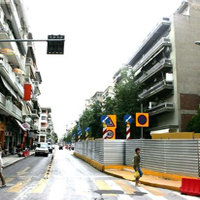The effect of locations of central metro stations on real estate values. A case study of Thessaloniki, Greece.
Abstract
Almost all of the most populated cities in the world have invested heavily on high capacity urban public transit systems. Apart from the direct economic benefits –travel time reduction, environmental benefits, some indirect benefits are the increase in real estate values (residential and commercial), improved accessibility and possible land use changes towards the development of an area. This study investigates the impact of the future central metro stations of Thessaloniki on real estate values. Real estate values can increase up to 11,3% at a distance shorter than 50 m and gradually decrease up to -14% for a distance greater than 500 m. A hedonic analysis is presented so as to determine the influence of metro stations to 52 commercial properties. The results of the investigation indicate that the changes in market are not necessarily connected or totally attributed to the construction of the metro stations. Instead interesting results show that in some cases common belief about the impact of urban public transit systems can be slightly different.
Downloads
References
Arbury J. (2005), From Urban Sprawl to Compact City – An analysis of urban growth management in Auckland, Thesis Auckland University, Auckland.
California Infracture Coalition (2006), Economic impact of funding California’s transportation infracture, California.
Cavill N., Kahlmeier S., Rutter H., Racioppi F., Oja P. (2008), Economic analyses of transport infracture and policies including health effects related to cycling and walking: A systematic review, Transport Policy, 15:291–304.
Debrezion G., Pels E., Rietveld P. (2007), The impact of railway stations on residential and commercial property value: a Meta-analysis, Journal of Real Estate Finance, Economics 35:161–180.
Dittmar H. and Ohland G. (2004), The New Transit Town: Best Practices in Transit-Oriented Development, Washington, D.C., Island Press.
European Environment Agency (EEA) (2006), Urban sprawl in Europe- The ignored challenge, Luxemburg, EC Joint Research Centre.
Ghebreegziabiher D., Pels E., Rietveld P. (2006), The impact of rail transport on real estate prices: an empirical analysis of the Dutch housing market, Amsterdam, Vrije University Amsterdam, and Tinbergen Institute.
Harrel F.E., (2002), Regression modeling strategies: With applications to linear models, logistic regression and survival analysis, New York and Berlin: Springer.
Jersey City UEZ (2011), Infracture, Jersey City Urban Enterprise Zone Program, Jersey.
Luchters G. and Chakrabarty S. (2006), Multicollinearity Detection, Shahjalal University of Science and Technology, Bangladesh.
OMEGA (2010), Greece- Athens Metro (Attiko Metro), Department of Planning and Regional Development, University of Thessaly, Greece.
Planning Commission TOD Committee (2011), Walking distance research, Fairfax County, Virginia.
Royal Institution of Chartered Surveyors (RICS) (2004), Land value and public transport, Office of the Deputy Prime Minister, London.
Smith J. and Gihring T. (2006), Financing transit systems through value capture: An annotated bibliography, American Journal of Economics and Sociology 65 (3): 751.
Spillar J.R. (1997), Park and Ride planning and design guidelines, Parsons Brinckerhoff Quade & Douglas, Inc., New York.
Swamy S. (2010), Impact of Delphi Metro on real estate, CEPT University.
Construction of Thessaloniki Metro, http://www.ametro.gr/page/default.asp?la=1&id=8, (retrieved on 02/04/2012).
Wooldridge J.M. (2003), Introductory econometrics, Thomson.

Copyright (c) 2014 Tema. Journal of Land Use, Mobility and Environment

This work is licensed under a Creative Commons Attribution 4.0 International License.
Authors who publish in this journal agree to the following:
1. Authors retain the rights to their work and give in to the journal the right of first publication of the work simultaneously licensed under a Creative Commons License - Attribution that allows others to share the work indicating the authorship and the initial publication in this journal.
2. Authors can adhere to other agreements of non-exclusive license for the distribution of the published version of the work (ex. To deposit it in an institutional repository or to publish it in a monography), provided to indicate that the document was first published in this journal.
3. Authors can distribute their work online (ex. In institutional repositories or in their website) prior to and during the submission process, as it can lead to productive exchanges and it can increase the quotations of the published work (See The Effect of Open Access)
